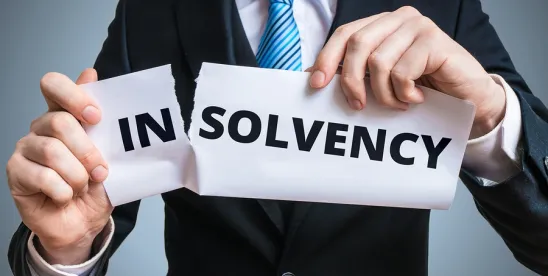Even prior to the global impact of COVID-19, commercial bankruptcy filings were already on the rise. As stay-at-home orders caused many businesses to close or significantly curtail operations in 2020, financial struggles in the commercial sector mounted. Government assistance through the passage of different stimulus programs such as the Coronavirus Aid, Relief, and Economic Security (CARES) Act (2020) and Coronavirus Response and Consolidated Appropriations Act (2021) has temporarily helped companies stave off difficult financial decisions. In addition, lenders may have been more willing to provide modifications to loan agreements to provide for some payment relief in the near term. However, as stimulus funds dry up and business returns to normal, many companies may find themselves still financially struggling with nowhere to turn. When a company’s financial performance declines to the point where it is approaching insolvency, the company’s directors and officers (D&Os) fiduciary duties to key stakeholders come to the forefront.
KEY TAKEAWAYS INCLUDE:
-
Remain cognizant of the different tests to determine whether a company is insolvent.
-
Know what duties they owe and to whom they are owed.
-
Ensure debts carrying personal liability are paid timely by the company.
-
Make sure the company has adequate D&O insurance coverage.
REMAIN COGNIZANT OF WHEN THE COMPANY APPROACHES INSOLVENCY
While Delaware clarified that a D&O only owes a duty to the corporation’s shareholders, creditors can bring claims for breaches of fiduciary against D&Os through a derivative action once the company is insolvent. It can be difficult to determine the exact point in which a company crosses the threshold to insolvency, but courts have routinely applied the following three tests:
-
Cash flow test: whether the company can pay its debts when they become due.
-
Balance sheet test: whether the company’s liabilities exceed the fair market value of its assets.
-
Adequate capital test: whether there is sufficient cash on hand to pay operating expenses, capital expenditures, and debt repayment obligations.
The failure of any one test renders the company insolvent. Other jurisdictions have held that D&Os owe direct fiduciary duties to creditors and some have held that those duties include creditors when a company enters the zone of insolvency. Therefore, D&Os of a company in financial distress should be cognizant of the creditor’s interests when making decisions.
KNOW YOUR DUTIES
Generally, D&Os owe a company (i) a duty of care to make informed decisions in good faith and in the best interest of the company, and (ii) a duty of loyalty, which require D&Os not to engage in self-dealing and to put the interests of the company ahead of their own. This means that D&Os should (i) continually monitor and evaluate the company’s financial performance, and (ii) avoid being involved in any decision-making where there is a potential conflict of interest. Frequently when a company fails, D&Os decision-making is examined. Even if the company is insolvent, courts will continue to defer to the business judgment rule. In doing so, an objective standard will be applied based upon whether the D&O’s actions were made with the care that an ordinarily prudent person would use in the same or similar circumstances. With that standard in mind, courts will review what options D&Os considered in making critical decisions. Some of those options include:
-
What actions were made to reduce expenses and how quickly were they implemented?
-
What efforts were made to restructure the company’s debts?
-
What was done to conserve cash?
-
Did the company pursue the sale of any or all of its assets?
-
Did the company consider an out-of-court workout, Chapter 11 bankruptcy or assignment for the benefit of creditors?
Unfortunately, D&Os actions are often reviewed in retrospect, and it is important to make sure that decisions are made with the proper corporate authority and that the basis for such decisions are thoroughly documented.
AVOID PERSONAL LIABILITY
While most company debts do not carry personal liability for D&Os, when the company enters the zone of insolvency the following actions and omissions may attach personal liability:
-
Wages: certain states provide for personal liability (and in some instances, criminal liability) for the “willful” failure to pay wages. In addition, the Federal Workers Adjustment and Retraining Notification Act and similar state requirements require advance notices to be provided to employees who may be laid off. Failure to provide timely notices has led to class action litigation against companies and their D&Os for breaches of their fiduciary duty.
-
Taxes: federal law provides for personal liability of certain officers who fail to remit the employee portion of FICA taxes. Some states also hold D&Os responsible for sales and franchise taxes owed by the company. In some instances, if a corporate charter is forfeited due to the failure of the company to pay franchise taxes, the state ignores the corporate existence and provides for personal liability for all of the company’s debts. If a company is not in bankruptcy, Section 3713 of Title 31 of the U.S. Code requires that an insolvent company pay the federal government prior to paying any of its other unsecured creditors or the representative can be held personally liable to the government to the extent of the payment for unpaid claims.
While D&Os may not typically be involved in the payment of these debts, given the potential personal liability, they will want to ensure that the company is making those payments.
MAINTAIN ADEQUATE D&O POLICIES AND CONSIDER TAIL COVERAGE
While the company may have a D&O policy in place, D&Os should review them to make sure there is no exclusion for insolvency or bankruptcy. Such coverage becomes harder to find and more expensive as the company becomes financially distressed. As these policies tend to be a source of recovery for claims against D&Os, the company should consider whether the policy limits are sufficient and whether any other exclusions or liability limits may exist. A D&O policy is typically a “claims made” policy, and only claims made while the policy is active are covered. Therefore, if the company is dissolving or may file for bankruptcy, the company may want to procure a tail policy that will cover any claims for a certain pre-determined amount of years. Typically, a tail policy is priced based upon a multiple of prior year premiums and the payment will need to be made when the policy is obtained.
WHAT TO EXPECT NEXT
Several factors can affect D&Os duties throughout a company’s life cycle. For financially distressed companies, D&Os experience significant challenges in carrying out those duties while also having every decision scrutinized by key stakeholders. D&Os should remain vigilant when a crisis occurs and be proactive in taking decisive actions to mitigate potential risks.





 />i
/>i

